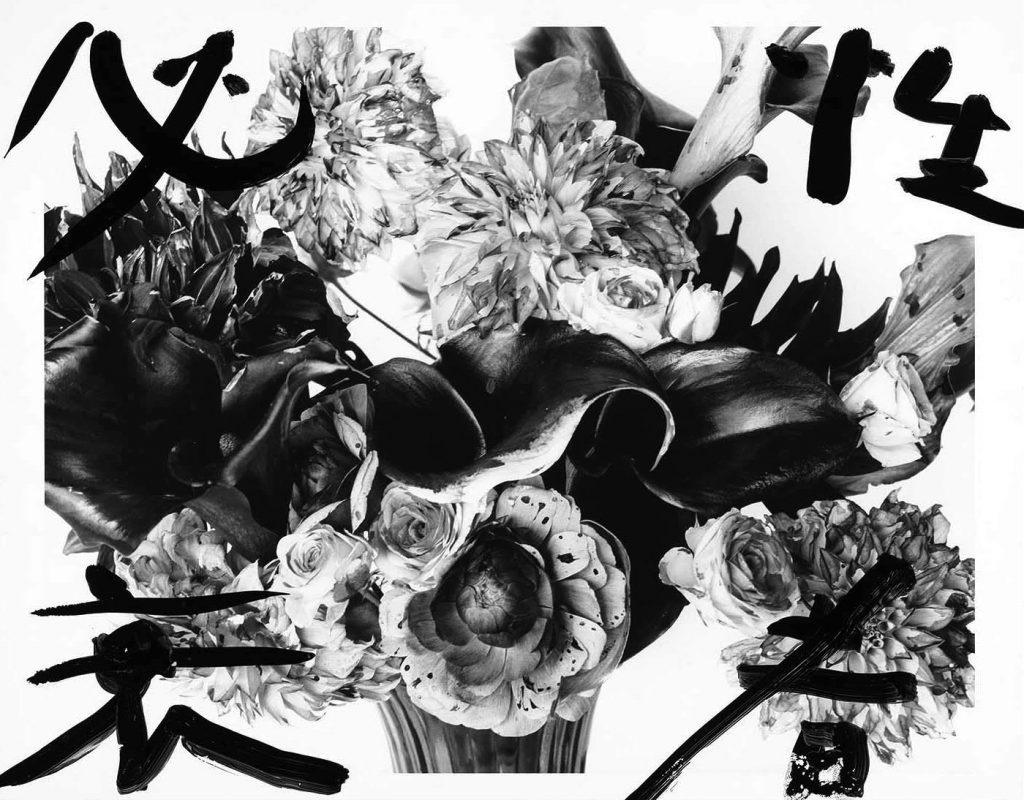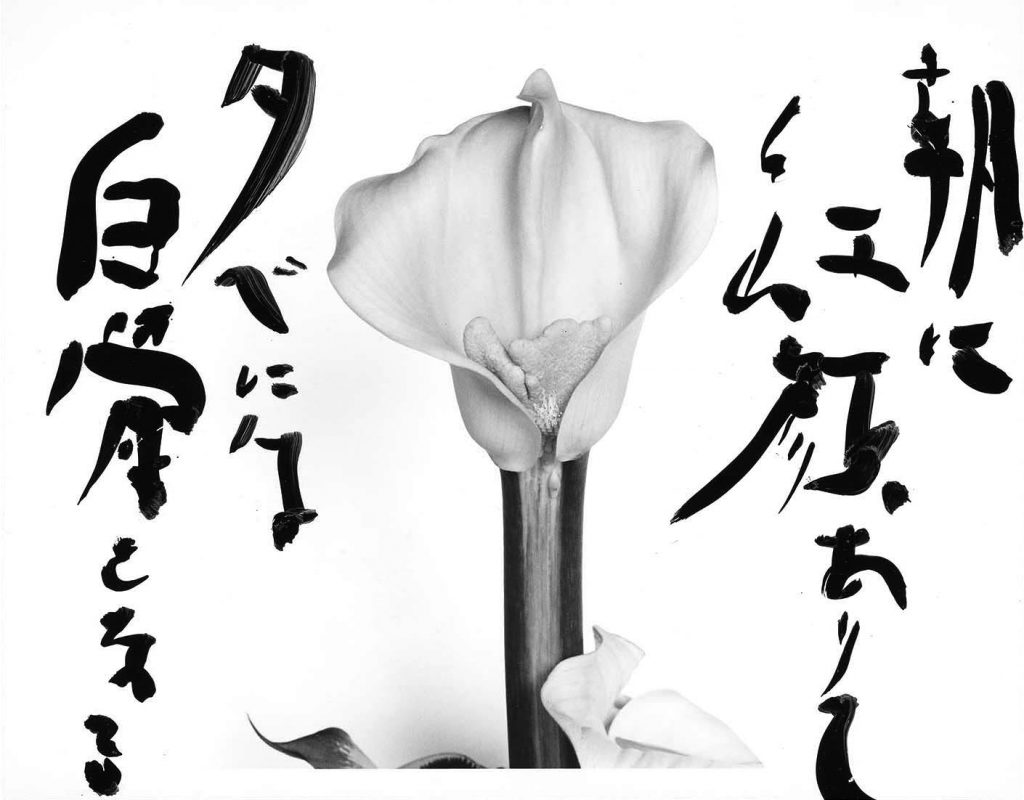Nobuyoshi Araki
Marvelous Tales of Black Ink
Special book review by Ivan Vartanian
One of Nobuyoshi Araki’s many wizard-like tricks is his ability to usher in the feeling that there is more than meets the eye. His photography seems to lean towards the grand and epic. Even is his most tender of moments – photographing his dying, beloved cat or taking snapshots of his newly wedded bride, Yoko, on their honeymoon trip – he seems to be able to connect to something that is on a cosmic order of magnitude. While this may indeed be the case on the level of content, I also know Araki to be an irrepressible and consummate showman. Little is left to chance in the scenarios and scenes that he builds for his images since he operates like a stage manager, directing all components on and off it. In a sense, Araki’s images are constructions in which each tier (including his crew, the lighting, and, of course, the model) is manipulated like marionettes. So when approaching a book such as Marvelous Tales of Black Ink, published by Morel Books, we cannot underestimate Araki’s level of clever play (read: calculation).
Each image in the book is illustrated with character forms written in brush pen. For a western audience, an already alien written system is made all the more difficult to decipher. This doesn’t mean Araki isn’t mindful of his audience; it’s just the opposite. He is fully aware that his readership won’t be able to make sense of the brushwork beyond an appreciation for its graphic effect. The calligraphy is a puzzle for which there may or may not be an answer. But being plainly read isn’t the point. Rather, what he is doing here is presenting a series of riddles and he asks the reader to step into that unknowable terrain without expectations of answers. The gesture here is one of pointing, not explaining.
Even being able to read Japanese, several of the writings in this book left me scratching my head. I had to do some research to parse some of his wordplays. Take, for example, the book’s title, which uses Chinese characters that are not part of everyday usage. The title is a direct reference to a novel by Kafu Nagai (1879-1959) written in 1937, called 濹東綺譚. The story is set in pre-war Japan and is about a retired novelist who has a brief love affair with a prostitute. It’s widely believed that the novel’s protagonist is a representation of the author. For the title of this photobook Araki has made one modification to the original: he’s replaced the second character entirely, changing it from 東 (east in English) to 汁 (liquid or juice). Perhaps this is meant emphasise the liquid nature of his brushwork’s India ink, which is what the title’s first character means.
Araki’s wordplay has been a consistent presence throughout his career. Apart from the copious volume of images that he continues to produce, Araki has also written a tremendous amount. In fact, in the late-1990s, a multiple-volume compendium of his writings was published that canvassed the extent of his essays, diaries, and other texts that are difficult to categorise. His sensitivity to language is perhaps also matched only by his irreverence for it. For every measure of aesthete musings, there is an equal measure of crass humour. He has often refered to his camera as a ca-mara. Mara is Japanese slang for penis; a more faithful translation would be “dick.” He is not only equating the camera with a phallus but also conflating the two words and the two ideas – a central tenant of Araki’s thoughts on photography.
Conflation of two forms into one is a running visual and thematic trope throughout Araki’s oeuvre. This trope is also a form of nodding to some other existing form or body of work. In terms of traditional Japanese aesthetics, this is called mitateru. The English word allusion approaches this idea to a certain degree. Where allusion calls to mind an existing work, mitateru borrows the referenced form en masse with some modification. As Araki has done with the title, he has borrowed from the novelist Nagai, the “original” (in Western parlance) is presented simultaneously as its revised form. This is less an act of plagiarism and more a play of forms, by calling to mind and asserting the presence of both the original and its revised version at the same time. In this instance, Araki is presenting himself as both the novelist Nagai and the fiction’s protagonist.
While the calligraphy was ostensibly all done at one time, the images are pulled from the photographer’s vast archive of images. The bondage images were a regular theme in Araki’s work in the 1990s. Suspending a nude from the ceiling and contorting the model in such an elevation requires is a highly sophisticated rope technique. Ensuring the safety and relative comfort of the model means that each of these shoots requires an elaborate staging production. Moreover, this floating technique seems to make use of a decidedly traditional Japanese space configuration (madori); the ropes are attached to exposed beams, which are typically found in a tatami room. An extension of this scenario is the kimono that the women wear, or in many cases don’t wear. The space and the vestments and the network of finely organised cords all point to a particular aestheticism. Araki is drawing our awareness to not only the content of what’s written but also our own processes of how we read those signifiers. Within this schema, the female form as an object of voyeuristic sexual desire is complicated, as evinced by Simon Baker’s afterword to the book, which references Georges Bataille in his discussion of the flowers images included in this volume. As such, the literary superstructure reinforces the complexity of how we are to read this book and the photographer’s base instincts are mitigated by the sophistication of the overall structure that he’s set into motion. Then again, maybe the joke’s on us. Personally, I’ve never known Araki to not mention his mara in nearly every conversation.
The book is a handsome production. The jacket of this oversized book feels like starched linen and the motif is raised. The choice of materials is refined and the printing, while simple, is done well. The coat of varnish on the plates is greatly appreciated. ♦
All images courtesy of Morel Books and Taka Ishii Gallery. © Nobuyoshi Araki
—
Ivan Vartanian is an American writer, curator, and publisher based in Tokyo. He is the co-author of Japanese Photobooks of the 1960s & 70s (Aperture, 2009) and Setting Sun: Writings by Japanese Photographers (Aperture, 2006), ArtWork: Seeing Inside the Creative Process (Chronicle Books, 2011), See/Saw: Connections Between Japanese Art Then & Now (Chronicle Books, 2011), and editor/producer of Egon Schiele: Drawings and Watercolors (Thames & Hudson, 2003). Vartanian also founded GOLIGA Books.











